
Newark Northgate railway station is on the East Coast Main Line serving the town of Newark-on-Trent, Nottinghamshire, England. It is 120 miles 8 chains (193.3 km) down the line from London King's Cross and is situated on the main line between Grantham to the south and Retford to the north. The station is Grade II listed.

Leicester Belgrave Road was the Great Northern Railway terminus in Leicester, England. It was the terminus of the GNR's branch line from the Great Northern and London and North Western Joint Railway at Marefield Junction.

Bottesford railway station serves the village of Bottesford in Leicestershire, England. The station is 15 miles east of Nottingham, on the lines to Grantham and Skegness. It is the least used station in Leicestershire.
Oldham Clegg Street railway station was the Oldham, Ashton-under-Lyne and Guide Bridge Junction Railway station that served the town of Oldham in northwest England, it had three associated goods stations.

Shirebrook North railway station was a railway station serving the town of Shirebrook in Derbyshire, England. It was on the Lancashire, Derbyshire and East Coast Railway running from Chesterfield to Lincoln. The station was also on the former Shirebrook North to Nottingham Victoria Line and the Sheffield District Railway. The station has since been demolished and housing now occupies parts of the site with some stub rails nearby serving a train scrapper.
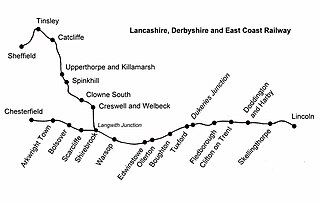
Ollerton railway station is a former railway station in Ollerton, Nottinghamshire, England.

Tuxford Central railway station is a former railway station in Tuxford, Nottinghamshire, England.

Thorpe on the Hill railway station was a station serving the village of Thorpe-on-the-Hill, Lincolnshire, England.
The Ambergate, Nottingham and Boston and Eastern Junction Railway was a British railway company, which hoped to connect Lancashire with the port of Boston, in Lincolnshire, England. It was authorised in 1846 but was unable to raise much money. It opened a standard gauge line from a junction near Nottingham to Grantham in 1853. At Nottingham it was to rely on the Midland Railway, but that company was hostile and obstructive.
The Great Northern and London and North Western Joint Railway was a British railway line, almost entirely within Leicestershire. Authorised by the same Act of Parliament, the Great Northern Railway Leicester Branch was built, branching from the Joint Line; on the same basis the Newark to Bottesford Line was built. The lines opened progressively between 1879 and 1883. The dominant traffic was iron ore, and the agricultural produce of the area served also generated considerable business. The passenger usage was never heavy, although some unusual through services were attempted at first.
Melton Mowbray North railway station was a railway station in Melton Mowbray, Leicestershire, England on the Great Northern and London and North Western Joint Railway.
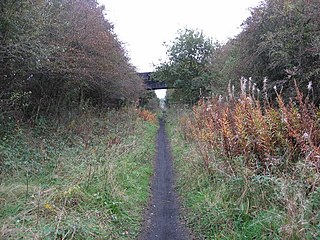
Pleasley East is a former railway station in Pleasley, Derbyshire, England on the Nottinghamshire border near Mansfield.
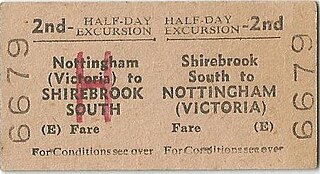
Shirebrook South is a former railway station in Shirebrook, north eastern Derbyshire, England.
The Clowne Branch is a disused railway line in north eastern Derbyshire, England. Which runs from Creswell to Staveley. Historically it ran to Chesterfield. It is now in use as a greenway.
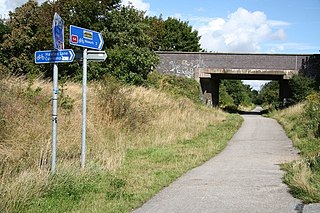
National Cycle Network (NCN) Route 64 is a Sustrans National Route that runs from Market Harborough to Lincoln. The route is 68 miles (109 km) in length and is fully open and signed in both directions. There are three sections to the route, NCN 63 and NCN 15 form the links between these sections.
The Boston, Sleaford and Midland Counties Railway opened a railway line between Grantham and Boston, through Sleaford, England. It opened in two stages, in 1857 and 1859.

Staunton is a small village and civil parish in the Newark and Sherwood district of Nottinghamshire, England. It takes its name from the Vale of Belvoir and shares it with the local Staunton family, which has resided in the area since the Norman Conquest and possibly before, making them one of the English families living longest on its own estate.
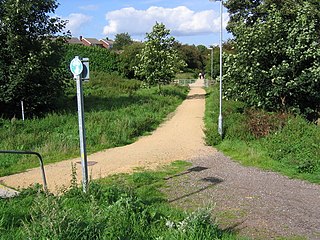
Skeby railway station served the village of Skegby, Nottinghamshire in England.

Sutton-in-Ashfield Town railway station or simply "Sutton Town" railway station served the market town of Sutton-in-Ashfield, Nottinghamshire in England.
The Nottingham direct line of the Midland Railway was a new route created in 1879 to relieve congestion on the established routes of the Midland Railway, in England. It consisted of two connecting lines that, together with part of an existing route, formed a new route from Nottingham to near Kettering. The line was used for Nottingham to London express passenger trains, and for heavy mineral and goods trains heading south. As well as shortening the transit a little, the new line had the effect of relieving congestion on the original main line through Leicester, that had become excessively congested.












